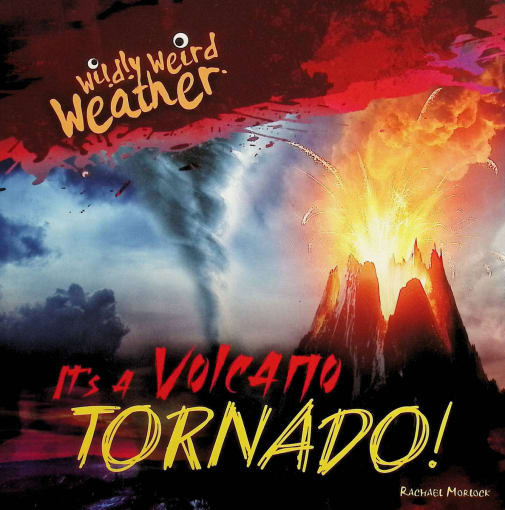Is it a volcano or is it a tornado? The answer is, YES! This science reader for elementary students covers earth science topics with vivid full-color photographs. First learn about volcanoes—how and where they form, what they contain, and what happens when they erupt. Then learn about the mechanics of tornadoes. Now, learn about the perfect storm that can occur when both natural occurrences happen at the same time. 24 pgs., pb. ~Rebecca
Wildly Weird Weather: It's a Volcano Tornado!
SKU
038306
ISBN
9781538287910
Grade 2-5
These icons are designed to help you quickly understand and learn important information about our products.
Teaching Method
Traditional
Teacher-centered curriculum commonly used in classrooms that may include a text, teacher manual, tests, etc.
Charlotte Mason
A methodology based on the work of a 19th century educator who maintained that children learn best from literature (Living Books), not textbooks.
Classical
A methodology based on the Latin Trivium (three stages of learning), including the grammar stage (memorization and facts), logic stage (critical thinking), and rhetoric stage (developing/defending ideas).
Unit Study
A thematic or topical approach centered around one topic that integrates multiple subject areas.
Montessori (Discovery)
A methodology based on the work of a 20th century educator that emphasizes student and sensory-driven discovery learning and real-life applications.
Other
Other methodologies
Religious Content
Secular
Contains content contrary to common Christian beliefs (i.e. evolution).
Neutral
Avoids religious or theoretical topics or presents multiple viewpoints without preference.
Christian/Religious
Faith-based or including instructional religious content.
Learning Modality
Auditory
Learns through listening, talking out loud or reading out loud.
Visual
Learns through seeing, prefers written instructions and visual materials.
Kinesthetic/Tactile (Hands-On)
Learns through moving, doing and touching.
Multi-Sensory
Curriculum that employ a variety of activities/components.
Presentation
Sequential
Curriculum progresses through well-defined learning objectives. Emphasizes mastery before moving to the next topic.
Spiral
Topics and concepts are repeated from level to level, adding more depth at each pass and connecting with review.
Conceptual/Topical
Focus is on the “why,” often with a unifying concept as well as specific skills; coverage may be broader.
Teacher Involvement
Low Teacher Involvement
Student-led materials; parent acts as a facilitator.
Medium Teacher Involvement
A mix of teacher-led time and independent student work.
High Teacher Involvement
Teacher-led lessons; may utilize discussions, hands-on activities and working together.
Additional Materials Required
No other materials needed
Everything you need is included.
Other Materials Required
There are additional required resources that are a separate purchase.
Other Materials Optional
There are additional resources mentioned or recommended but are not absolutely necessary.
Consumable
Consumable
Designed to be written in; not reusable.
Non-Consumable
Not designed to be written in; reusable.
Our Price
$9.15 $9.15 $6.75
Rainbow Savings: $2.40
Product Overview
- A wacky series to pique any young reader’s interest!
- Nonfiction readers help students become experts and share what they know!
- A fun series to add to an Earth Science unit or weather study
Description
Publisher's Description of Wildly Weird Weather: It's a Volcano Tornado!
What's more frightening than a volcano? A tornado that forms from a
volcano! A volcano tornado is a spinning vortex of air, formed from
severe high heat. These deadly spinning columns can spew hot lava,
leaving destruction in their wake. In this book, readers will learn all
about this unique natural phenomenon. They'll discover historic examples
of when volcano tornados have formed and the havoc they wreaked.
Vibrant photographs and informative fact boxes add dimension to the
high-interest material.
Category Description for Wildly Weird Weather
Enrich elementary students’ science studies with these nonfiction readers. Jam-packed with factoids, vivid full-color photographs, and quirky topics, these books instantly engage young readers. Each book also provides a glossary of new words that can be used as spelling or vocabulary words, further information on the topic either through additional books or websites, and an index to help look up quick facts. Each book covers a weird occurrence in nature—whether it is raining frogs, snow in Hawaii, or things being struck by lightning. Learn the science behind these natural wonders. ~Rebecca
Details
| Product Format: | Paperback |
|---|---|
| Grades: | 2-5 |
| Brand: | Gareth Stevens |
| ISBN: | 9781538287910 |
| Length in Inches: | 8.8125 |
| Width in Inches: | 7.75 |
| Height in Inches: | 0.9375 |
| Weight in Pounds: | 0.15 |
Videos
Reviews

